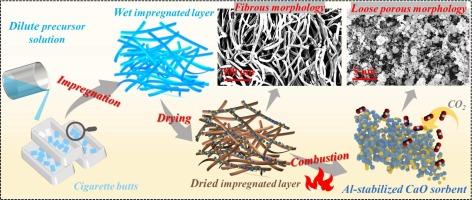Inert stabilizer enhanced CaO sorbents for CO2 capture: Insights through impregnated layer solution combustion synthesis
IF 6.7
1区 工程技术
Q2 ENERGY & FUELS
引用次数: 0
Abstract
Calcium Looping (CaL) holds great promise for high-temperature CO2 capture in the post-combustion phase. In this work, impregnated layer solution combustion (ILSC) was employed to synthesize the highly efficient Al-stabilized CaO-based CO2 sorbents. A comparative investigation was conducted on the dry and wet ILSC modes with discarded cigarette butts as the impregnated layer. The research delved into the impact of precursor solution concentration on the micromorphology, porosity, and CO2 capture capacity of the synthesized Al-stabilized CaO-based sorbent, shedding light on the associated mechanisms. Research reveals that CaO-based sorbents made via the ILSC process with lower precursor solution concentrations (i.e., liquid-to-solid ratios of 3.0 and 3.75) outperform those made with higher concentrations (i.e., liquid-to-solid ratios of 1.0 and 1.5). Notably, the sorbent produced via the wet ILSC mode with a low concentration precursor solution at a liquid-to-solid ratio of 3.0 shows remarkable cyclic CO2 capture capabilities. It maintains a capture capacity of 0.383 g CO2/g calcined sorbent in the 17th cycle, which is 70.8 % of its initial capacity. The dilute precursor solution is capable of sustaining the initial fibrous integrity of cigarette butts, unlike its concentrated counterpart, which destroys the fiber structure. This solution also enhances the uniform dispersion of Ca and Al and suppresses the high-temperature agglomeration of CaO grains.

用于捕获二氧化碳的惰性稳定剂增强型氧化钙吸附剂:浸渍层溶液燃烧合成的启示
钙循环(CaL)在燃烧后阶段的高温二氧化碳捕集方面前景广阔。本研究采用浸渍层溶液燃烧(ILSC)技术合成了高效的铝稳定氧化钙基二氧化碳吸附剂。以废弃烟头为浸渍层,对干法和湿法 ILSC 模式进行了比较研究。研究深入探讨了前驱体溶液浓度对合成的铝稳定氧化钙基吸附剂的微观形貌、孔隙率和二氧化碳捕获能力的影响,并揭示了相关机理。研究发现,通过 ILSC 工艺制作的前驱体溶液浓度较低(即液固比为 3.0 和 3.75)的氧化钙基吸附剂优于浓度较高(即液固比为 1.0 和 1.5)的吸附剂。值得注意的是,在液固比为 3.0 的低浓度前驱体溶液中,通过湿法 ILSC 模式制得的吸附剂显示出卓越的二氧化碳循环捕获能力。在第 17 个循环中,它的捕集能力保持在 0.383 克 CO2/克煅烧吸附剂,是其初始捕集能力的 70.8%。稀释的前驱体溶液能够保持烟头最初的纤维完整性,而不像浓缩的前驱体溶液会破坏纤维结构。这种溶液还能提高 Ca 和 Al 的均匀分散性,抑制 CaO 晶粒的高温团聚。
本文章由计算机程序翻译,如有差异,请以英文原文为准。
求助全文
约1分钟内获得全文
求助全文
来源期刊

Fuel
工程技术-工程:化工
CiteScore
12.80
自引率
20.30%
发文量
3506
审稿时长
64 days
期刊介绍:
The exploration of energy sources remains a critical matter of study. For the past nine decades, fuel has consistently held the forefront in primary research efforts within the field of energy science. This area of investigation encompasses a wide range of subjects, with a particular emphasis on emerging concerns like environmental factors and pollution.
 求助内容:
求助内容: 应助结果提醒方式:
应助结果提醒方式:


